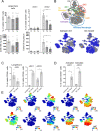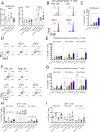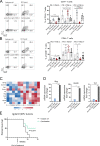Skin dendritic cells in melanoma are key for successful checkpoint blockade therapy
- PMID: 33408092
- PMCID: PMC7789456
- DOI: 10.1136/jitc-2020-000832
Skin dendritic cells in melanoma are key for successful checkpoint blockade therapy
Abstract
Background: Immunotherapy with checkpoint inhibitors has shown impressive results in patients with melanoma, but still many do not benefit from this line of treatment. A lack of tumor-infiltrating T cells is a common reason for therapy failure but also a loss of intratumoral dendritic cells (DCs) has been described.
Methods: We used the transgenic tg(Grm1)EPv melanoma mouse strain that develops spontaneous, slow-growing tumors to perform immunological analysis during tumor progression. With flow cytometry, the frequencies of DCs and T cells at different tumor stages and the expression of the inhibitory molecules programmed cell death protein-1 (PD-1) and T-cell immunoglobulin and mucin-domain containing-3 (TIM-3) on T cells were analyzed. This was complemented with RNA-sequencing (RNA-seq) and real-time quantitative PCR (RT-qPCR) analysis to investigate the immune status of the tumors. To boost DC numbers and function, we administered Fms-related tyrosine 3 ligand (Flt3L) plus an adjuvant mix of polyI:C and anti-CD40. To enhance T cell function, we tested several checkpoint blockade antibodies. Immunological alterations were characterized in tumor and tumor-draining lymph nodes (LNs) by flow cytometry, CyTOF, microarray and RT-qPCR to understand how immune cells can control tumor growth. The specific role of migratory skin DCs was investigated by coculture of sorted DC subsets with melanoma-specific CD8+ T cells.
Results: Our study revealed that tumor progression is characterized by upregulation of checkpoint molecules and a gradual loss of the dermal conventional DC (cDC) 2 subset. Monotherapy with checkpoint blockade could not restore antitumor immunity, whereas boosting DC numbers and activation increased tumor immunogenicity. This was reflected by higher numbers of activated cDC1 and cDC2 as well as CD4+ and CD8+ T cells in treated tumors. At the same time, the DC boost approach reinforced migratory dermal DC subsets to prime gp100-specific CD8+ T cells in tumor-draining LNs that expressed PD-1/TIM-3 and produced interferon γ (IFNγ)/tumor necrosis factor α (TNFα). As a consequence, the combination of the DC boost with antibodies against PD-1 and TIM-3 released the brake from T cells, leading to improved function within the tumors and delayed tumor growth.
Conclusions: Our results set forth the importance of skin DC in cancer immunotherapy, and demonstrates that restoring DC function is key to enhancing tumor immunogenicity and subsequently responsiveness to checkpoint blockade therapy.
Keywords: dendritic cells; immunomodulation; immunotherapy; melanoma; tumor microenvironment.
© Author(s) (or their employer(s)) 2021. Re-use permitted under CC BY. Published by BMJ.
Conflict of interest statement
Competing interests: None declared.
Figures






Similar articles
-
In situ delivery of iPSC-derived dendritic cells with local radiotherapy generates systemic antitumor immunity and potentiates PD-L1 blockade in preclinical poorly immunogenic tumor models.J Immunother Cancer. 2021 May;9(5):e002432. doi: 10.1136/jitc-2021-002432. J Immunother Cancer. 2021. PMID: 34049930 Free PMC article.
-
Human CD141+ dendritic cells (cDC1) are impaired in patients with advanced melanoma but can be targeted to enhance anti-PD-1 in a humanized mouse model.J Immunother Cancer. 2021 Mar;9(3):e001963. doi: 10.1136/jitc-2020-001963. J Immunother Cancer. 2021. PMID: 33737342 Free PMC article.
-
Targeting STAT3 Abrogates Tim-3 Upregulation of Adaptive Resistance to PD-1 Blockade on Regulatory T Cells of Melanoma.Front Immunol. 2021 Apr 15;12:654749. doi: 10.3389/fimmu.2021.654749. eCollection 2021. Front Immunol. 2021. PMID: 33936081 Free PMC article.
-
Inhibitory Checkpoint Receptor TIM-3 as a Regulator of the Functional Activity of Dendritic Cells.Bull Exp Biol Med. 2024 Jul;177(3):287-292. doi: 10.1007/s10517-024-06175-z. Epub 2024 Aug 10. Bull Exp Biol Med. 2024. PMID: 39123087 Review.
-
Dendritic cell gene therapy.Surg Oncol Clin N Am. 2002 Jul;11(3):645-60. doi: 10.1016/s1055-3207(02)00027-3. Surg Oncol Clin N Am. 2002. PMID: 12487060 Review.
Cited by
-
New Therapeutic Approaches for Conjunctival Melanoma-What We Know So Far and Where Therapy Is Potentially Heading: Focus on Lymphatic Vessels and Dendritic Cells.Int J Mol Sci. 2022 Jan 27;23(3):1478. doi: 10.3390/ijms23031478. Int J Mol Sci. 2022. PMID: 35163401 Free PMC article. Review.
-
Tetraspanin CD9 Expression Predicts Sentinel Node Status in Patients with Cutaneous Melanoma.Int J Mol Sci. 2022 Apr 26;23(9):4775. doi: 10.3390/ijms23094775. Int J Mol Sci. 2022. PMID: 35563166 Free PMC article.
-
Tissue Biomarkers Predicting Lymph Node Status in Cutaneous Melanoma.Int J Mol Sci. 2022 Dec 21;24(1):144. doi: 10.3390/ijms24010144. Int J Mol Sci. 2022. PMID: 36613587 Free PMC article. Review.
-
Guidelines for preparation and flow cytometry analysis of human nonlymphoid tissue DC.Eur J Immunol. 2025 Jan;55(1):e2250325. doi: 10.1002/eji.202250325. Epub 2024 Dec 12. Eur J Immunol. 2025. PMID: 39668411 Free PMC article.
-
Oncolytic alphavirus replicons mediated recruitment and activation of T cells.iScience. 2024 Feb 16;27(3):109253. doi: 10.1016/j.isci.2024.109253. eCollection 2024 Mar 15. iScience. 2024. PMID: 38425844 Free PMC article.
References
Publication types
MeSH terms
Substances
Grants and funding
LinkOut - more resources
Full Text Sources
Other Literature Sources
Research Materials
Miscellaneous
